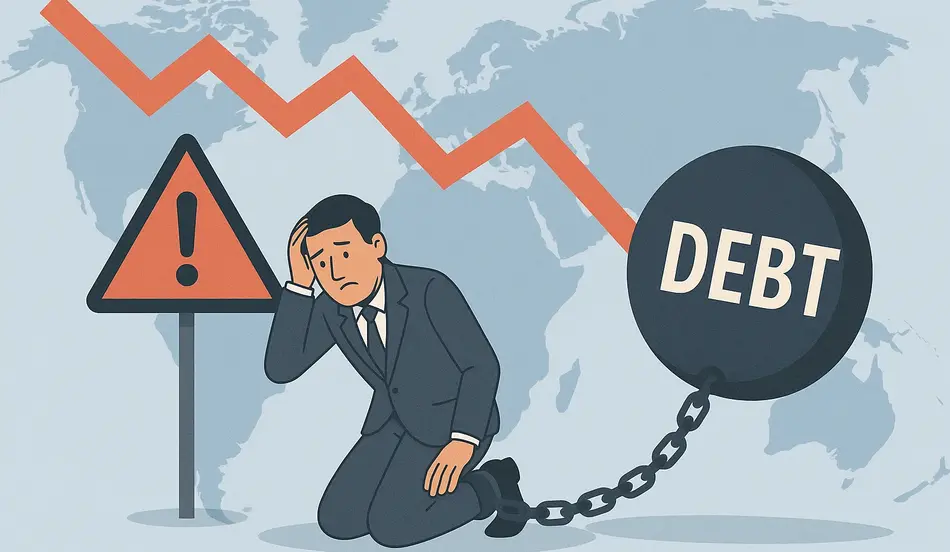The global economy is showing concerning signals that many economists are watching closely. As national debts continue to climb worldwide, understanding the warning signs of potential crisis becomes increasingly important for investors, policymakers, and citizens alike.
Table of Contents
Unprecedented Warning Signs of a Looming Debt Crisis
The recent tariff announcement triggered something that shocked economists worldwide – not just a stock market decline, but a surprising drop in the value of the US dollar. Traditionally, during market turmoil, the dollar strengthens as investors seek safety in US assets. However, we witnessed the opposite: “Money fled from the US for safety instead of to the US for safety for the first time in my memory,” noted one economic expert.
This unprecedented reaction signals a fundamental shift in global investor confidence. People aren’t merely reallocating between US assets; they’re growing increasingly nervous about US assets altogether. This concerning development coincided with credit rating downgrades for the US, primarily attributed to the mounting national debt.
Understanding the National Debt Crisis
What Exactly Is National Debt?
For over two decades, the United States Congress has consistently spent more than it collects through tax revenue, creating persistent budget deficits. The 2020 deficit alone added $1.8 trillion to the cumulative national debt from previous years, resulting in a staggering total that continues to grow.
While absolute numbers can be difficult to contextualize, examining the debt as a percentage of GDP provides a clearer picture. Currently, US national debt has reached levels comparable to those during World War II – a period when extraordinary debt was justified by extraordinary circumstances.
How National Debt Financing Works
The US Treasury raises money by selling bonds and securities, primarily through auctions to various investors:
- Private domestic investors seeking stable returns
- Foreign governments and investors looking for safe havens
- Companies and pension funds seeking safe assets for their portfolios
As one economist explains: “Some government debt is actually a good thing because it allows households to basically save in a low-risk asset.” However, when debt levels become excessive, the benefits quickly transform into significant economic risks.
When Debt Becomes Dangerous: Critical Warning Signs
The Opportunity Cost of Excessive Debt
When investors purchase treasury securities, that capital isn’t flowing to productive sectors of the economy:
- Not funding corporate investments and innovation
- Not supporting bank loans for housing and development
- Not financing infrastructure improvements
“That $1.8 trillion is not available to whatever it may be that makes the economy more productive and allows us to live better. And that’s why it matters to the average person,” explains a leading economist.
Research indicates that reducing the debt to more sustainable levels by 2050 could increase per-person incomes by nearly 7%. This highlights how the national debt “affects basically everything in our economic lives, and then some, but we don’t see it, we don’t feel it, and many people don’t realize it.”
The Interest Payment Trap
In 2024, the US government spent more on interest payments for the national debt than on military expenditures or many essential government services combined. This creates a dangerous cycle:
“We have so much debt that we’re borrowing to pay the interest on the previous debt. Well, that’s like getting a new credit card to pay off the old one. And if you’re doing that, you’re in trouble.”
Even minor interest rate increases have massive implications: “If interest rates go up just one percentage point more than they’re expected to, it adds about $300 billion in borrowing a year.” This additional borrowing creates a vicious cycle that becomes increasingly difficult to escape.
The Tipping Point: When Does Debt Become Unsustainable?
The Critical Thresholds
Economic experts identify specific debt-to-GDP ratios that signal severe danger:
- 175% of GDP: At this level, fiscal management becomes extremely difficult
- 200% of GDP: The “drop dead limit” where tax increases cannot cover interest payments
“That’s the Greek-Portugal meltdown scenario,” warns one expert, referencing previous sovereign debt crises that devastated economies. When countries reach these thresholds, their options for financial recovery become severely limited.
The Unpredictable Trigger Point
While these percentages provide general guidelines, the actual breaking point could arrive much sooner:
“As soon as capital markets believe that Congress and the President, they are not gonna get their act together, everything unravels, and it unravels very quickly.”
The recent dollar decline after tariff announcements offered a glimpse of this potential scenario. When investors lose confidence in US assets, they demand higher interest rates, creating ripple effects throughout the entire economy.
💼 Hiring? Post Financial Sector Jobs with WhatJobs
Are you recruiting for positions in economics, finance, or government fiscal policy? Connect with experienced professionals by posting your job openings for free on WhatJobs . Reach top-tier talent with expertise in economic policy and financial management—especially valuable during these uncertain economic times.
📣 Post Finance Jobs for Free NowThe Domino Effect of a Debt Crisis
How Rising Interest Rates Impact Everything
US Treasury securities are considered the safest investment in the world, serving as the benchmark for all other interest rates:
- Mortgage rates for homebuyers
- Corporate bond rates for business financing
- Consumer loan rates for personal borrowing
When treasury rates rise due to debt concerns, “it ripples through the entire economy in ways that hurts all of us.” Higher borrowing costs affect everything from home purchases to business expansion to consumer spending.
Limited Crisis Response Options
High debt levels severely restrict the government’s ability to respond to future emergencies:
“The problem with a debt crisis is that once it happens, you can’t just debt your way out of it.”
“We might be able to borrow during the next crisis. All we know is we have less space to do so than we otherwise would have.”
This limitation becomes particularly problematic during economic downturns, pandemics, or natural disasters when government intervention is most needed.
Solutions to the National Debt Crisis
Can We Grow Our Way Out?
Some policymakers suggest that economic growth alone could solve the debt problem. Higher GDP and increased tax revenue would theoretically improve the debt-to-GDP ratio.
However, economists largely disagree with this approach: “You can’t grow your way out of this. Most spending is already tied to economic growth.” This reality makes it clear that more comprehensive solutions are needed.
The Necessary Hard Choices
Experts emphasize that addressing the debt requires a comprehensive approach:
- Spending reductions:
- Reform Social Security facing insolvency
- Address Medicare trust fund challenges
- Improve welfare program efficiency
- Eliminate waste in defense procurement
- Revenue increases:
- Implement necessary tax reforms
- Create sustainable revenue streams
“We need a grand bargain that says, ‘Everything’s on the table.'” This approach requires political courage and bipartisan cooperation that has proven elusive in recent decades.
FAQ: Global Debt Crisis Warning Signs
What are the most concerning warning signs of a potential global debt crisis?
The most alarming global debt crisis warning signs include unprecedented movements in currency markets where investors flee traditionally safe US assets, credit rating downgrades of major economies, rising interest payments consuming larger portions of national budgets, and debt-to-GDP ratios approaching critical thresholds of 175-200%. The recent phenomenon where “money fled from the US for safety instead of to the US for safety” represents a fundamental shift in global investor confidence that hasn’t been seen in modern economic history. When combined with the US national debt reaching World War II levels as a percentage of GDP, these warning signs suggest increasing vulnerability to economic shocks.
How does excessive national debt impact everyday citizens even before a crisis occurs?
Excessive national debt impacts everyday citizens through multiple channels even before reaching crisis levels. When government borrowing consumes $1.8 trillion that could otherwise fund productive private investment, it reduces economic growth potential and limits job creation. Research shows that reducing debt to sustainable levels could increase per-person incomes by nearly 7%. Additionally, interest payments on the debt already exceed military spending, diverting resources from essential services. The “opportunity cost” of debt means less capital available for corporate expansion, housing development, and infrastructure improvements that would directly benefit citizens. As one economist explained, the national debt “affects basically everything in our economic lives” from mortgage rates to retirement security.
What specific debt-to-GDP ratio indicates a potential global debt crisis, and why?
Economic experts identify 175% debt-to-GDP as the threshold where global debt crisis warning signs become severe, with 200% representing the “drop dead limit.” At these levels, countries cannot feasibly raise enough tax revenue to cover interest payments, triggering the “Greek-Portugal meltdown scenario.” However, the actual crisis point can occur well before these percentages are reached if market confidence erodes. The critical factor is investor perception – “As soon as capital markets believe that Congress and the President are not going to get their act together, everything unravels, and it unravels very quickly.” This explains why early warning signs like unusual currency movements and credit downgrades deserve serious attention, as they may signal approaching debt sustainability problems before statistical thresholds are crossed.
Why can’t countries simply grow their economies to solve the global debt crisis warning signs?
While economic growth improves the debt-to-GDP ratio mathematically, experts explain that countries “can’t grow their way out of this” debt problem for several reasons. First, most government spending programs are already indexed to economic growth, meaning expenses automatically increase alongside GDP. Second, the existing debt burden is so substantial that even robust growth rates would be insufficient to meaningfully reduce the ratio. Third, high debt levels themselves constrain growth potential by diverting capital from productive investments. The global debt crisis warning signs we’re seeing indicate structural fiscal imbalances that require comprehensive solutions including both spending reforms and revenue adjustments. As one economist noted, “You solve the fiscal problem, you spur economic growth” – not the other way around, highlighting why growth alone cannot address the fundamental sustainability issues in national debt trajectories.
Explore international job opportunities that may be more resilient during debt crises
Conclusion: The Unseen Debt Crisis
The national debt presents a unique challenge because its effects remain largely invisible until a crisis point is reached. As one expert summarizes: “Is the debt bad? It’s not until it suddenly is.”
The warning signs are becoming increasingly apparent:
- Unusual currency market movements
- Credit rating downgrades
- Interest payments consuming larger budget portions
- Debt-to-GDP ratios approaching dangerous thresholds
The solution requires political courage to make difficult but necessary fiscal adjustments before a crisis forces far more painful choices. “It doesn’t have to be draconian, but it does have to be different than what we’re doing now.”
Understanding these global debt crisis warning signs isn’t merely an academic exercise—it’s essential for businesses, investors, and individuals to prepare for potential economic turbulence ahead.
Find financial sector job opportunities during economic uncertainty on WhatJobs




